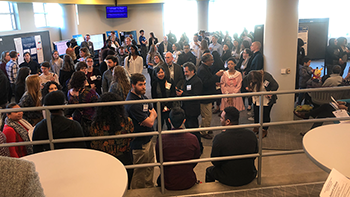Predicting the Future of Our Oceans Using Cyanobacteria (Synechococcus): How Ocean Acidification May Impact Our Primary Producers
Description/Abstract/Artist Statement
Synechococcus is a unicellular, photosynthetic, marine cyanobacteria that is found globally in temperate to tropical regions and is capable of living in conditions of variable salinity and light intensity. These microscopic organisms can provide bioeconomic services to humans, but can also negatively impact us in several ways. To further understand how these species react to our changing climate, we aimed to research what other conditions this species can tolerate. We subjected Synechococcus to two contrasting pH levels by manipulating the concentration of carbon dioxide (CO2) to test the cyanobacterium’s survivability and exponential growth through CO2 bubbling. Biomass was obtained using in vivo fluorescence to determine the effect on growth rates, and pH was recorded to ensure consistency within the two treatments. We concluded that no significance was found between the ambient air and elevated CO2 treatments. This outcome may be the result of a shorter experiment time, since other similar experiments are conducted throughout several generations, but leaves the opportunity to further explore this species’ threshold to changes in ocean acidity as well as rising temperatures.
Faculty Advisor/Mentor
Anna Tansik
Presentation Type
Poster
Disciplines
Marine Biology
Session Title
Poster Session
Location
Learning Commons, Atrium
Start Date
2-8-2020 8:00 AM
End Date
2-8-2020 12:30 PM
Predicting the Future of Our Oceans Using Cyanobacteria (Synechococcus): How Ocean Acidification May Impact Our Primary Producers
Learning Commons, Atrium
Synechococcus is a unicellular, photosynthetic, marine cyanobacteria that is found globally in temperate to tropical regions and is capable of living in conditions of variable salinity and light intensity. These microscopic organisms can provide bioeconomic services to humans, but can also negatively impact us in several ways. To further understand how these species react to our changing climate, we aimed to research what other conditions this species can tolerate. We subjected Synechococcus to two contrasting pH levels by manipulating the concentration of carbon dioxide (CO2) to test the cyanobacterium’s survivability and exponential growth through CO2 bubbling. Biomass was obtained using in vivo fluorescence to determine the effect on growth rates, and pH was recorded to ensure consistency within the two treatments. We concluded that no significance was found between the ambient air and elevated CO2 treatments. This outcome may be the result of a shorter experiment time, since other similar experiments are conducted throughout several generations, but leaves the opportunity to further explore this species’ threshold to changes in ocean acidity as well as rising temperatures.


